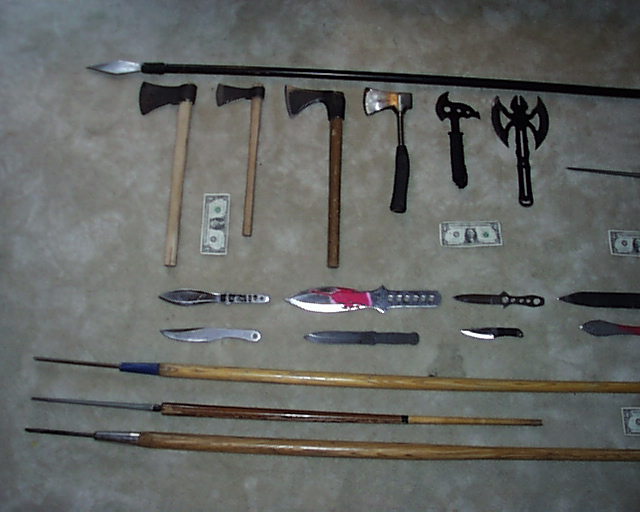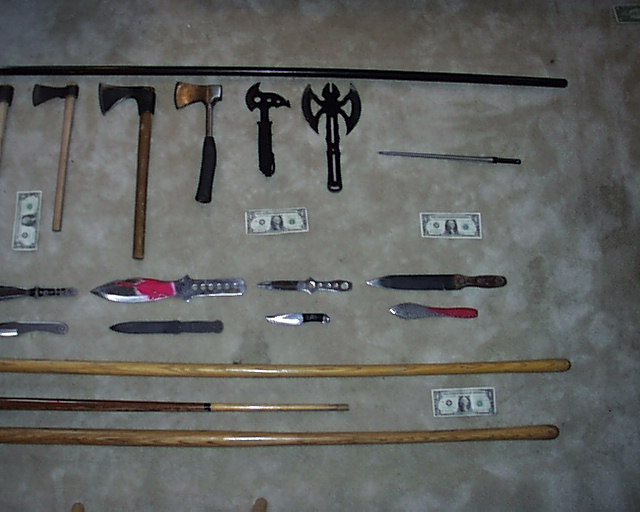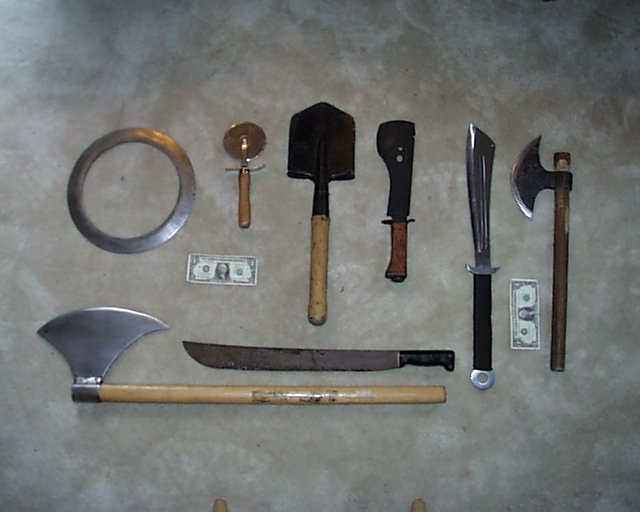
Types
of Weapons
There is a dizzying
array of weapons available that can be thrown. Shown here are more
common examples but keep in mind every manufacturer has unique
dimensions they use and in the case of the forged tomahawks they're
each made by hand, one at a time. A popular source for axes in the East
carries half a dozen different french hawks, he lists the different
weights in ounces. In the East, we like to keep an open mind and
try not to restrict a weapon for anything other than it being damaged
(see the current rules section.) However, weapons that offer a
mechanical advantage (atl-atls, slings, etc.) are not allowed in SCA
thrown weapons due to the space required for safe use. Below are photos
showing the more common weapons available (the dollar bills in the
picture are to help you with the size of the weapons.)

With the axes going left to right, starting at the top:
Forged "standard" tomahawk. This is as close to "standard" as you can get. This is the first weapon an adult will be given by the average marshal. Except for spears, the ax or tomahawk is the easiest weapon to throw and make stick. These hawks are sold by most merchants for a reasonable price (usually just over 20 dollars each,) and have easily replaced handles. If you don't get to throw a second time for six months, the marshal at the second event is very likely to have the same size and weight weapon you learned on the first time. 18" overall length, 3 1/2" blade length, 2 lbs.
Small forged (or mouse) tomahawk. Take the hawk mentioned above, run it through the dryer too long and you have a mouse hawk (it's roughly 2/3 to 3/4 the size and weight of the standard forged hawk.) This is a good weapon for children to use until they're older or smaller adults to get started with. It has been my experience that a smaller adult does better with the mouse hawk to focus on proper throwing technique first, then go to the standard hawk when they can relax enough to throw harder for the standard hawk. The normal turn around time from mouse hawk to standard is half an hour. If a student doesn't ask for the heavier weapon by then I offer it to them to try. Maybe 10% of my students decide to stay with the mouse hawk (one of whom is over 6' and fights in the unbelted tourneys.) 14" overall length, 2" blade length, 1 lbs.
French hawk. Probably the most recognizable tomahawk you'll find on the range. This is a very old style that is excellent for throwing. The raised tip of the head allows the french hawk to stick over a greater range of rotation (i.e.: it's more forgiving on improper throws. See Basic Throwing Technique for more on that.) The french hawks have the broadest range of weight and size of any ax design, but in weight they're generally between the standard and mouse hawks. 18"-20" overall length, 3 1/2" blade length.
Camping ax. Although not period, they're readily available in any hardware store and can be bought for as little as 5 dollars. The handles are made from wood or steel (head is permanently attached with steel handled axes.) The obvious advantage with the all steel ax is the handle doesn't break. A wooden tomahawk handle averages 5 dollars, and as a courtesy it's asked if you are using someone else's weapon you replace any of their handles you break (we found this policy speeds the learning curve, too.) Can they be thrown as well as the hawks listed above? Who's to say. The throwers who use them seem attached to them.
Throwing knives. We aren't even going to pretend to cover all the sizes and styles available. Knives are harder to throw than axes, since they are made to only stick on their blade tip. If the tip isn't almost perpendicular to the target face when it reaches the target, the knife is very likely to just bounce off. For this reason marshals encourage beginners to start with axes so they aren't discouraged quickly. Larger knives are generally easier (they throw like axes.) Knives eight inches from end to end are a minimum length that should be considered, but the heavier the better. Everyone when starting out wants to use tiny knives (must be a carry over from dart throwing.) For the beginner look for knives that a straight line could run through from end to end. Sweeping curved blades like Arabian scimitars aren't as easy to stick. Many knives made for throwing are made of one piece of steel with no additional handle material (wood or leather.) These are a good choice as you're going to hit the handle against the target multiple times until your skill increases. Note in the Current Rules a damaged handle can be reason for a marshal to fail a weapon and forbid it's use on the range.
Speaking of damaged knife handles: that favorite custom made irreplaceable awfully expensive knife you've had for years that you want to be buried with? Don't throw it. Ever. I don't care how well made or durable it is nothing makes your new knife become your old knife faster than throwing. This also applies to any folding knife.
Spears. In SCA thrown weapons spears aren't as popular as axes and knives. Spears can quickly cost more than most weapons (including two-handed axes,) they take up the most space, and since they don't rotate through the air like other weapons they can be almost boring to throw. I used to believe all of those things but thankfully a few people took an interest in spears and we are slowly coming around. Spears can be made cheaply from hardware store materials and they don't have to be eight feet long. If they look simple to throw you're right - that's why we all look so dumb when we can't hit the target without practice. The spear at the top of the photos is a flat steel head on a wood mop handle. The handles of all the spears on the bottom of the page were made from rake handles or pool cues. The heads were made from large nails/spikes or an SKS bayonet (like the one pictured below on the far right next to the axes.)

Pictured below are some stranger weapons to be found on the range. Starting from the top going left to right:

Shakra. Thrown like a frisbee (this means it's a sidearm throw and needs to be cleared with the marshal.)
Pizza cutter. Throw like a knife, stick like a bee.
Special Forces Shovel. The manufacturer claims this can be thrown like an ax as the edges can be sharpened. Despite the name, all the Special Forces folks I asked said this would not be their weapon of choice when the chips were down (how many war memorials in parks have you seen with shovels on someone's shoulder?) That said, it does stick nice and the looks you get (from the newer throwers anyway) are worth the effort.
Bolo machete/knife. Military styled heavy knife. This particular weapon doesn't have a point, but will stick when thrown correctly.
Chinese sword. Knives don't get much heavier than this (no that's not a challenge.)
Viking/Norse ax. Essentially a different style of tomahawk.
Machete. Long rotation, light weight. This can be tough to throw on a windy day. The blade is tempered like a spring (on the good ones anyway) so if it doesn't stick it could bounce much further than some weapons.
Two-handed ax. These are attention getters on the range. Funny how conversations taper off and other throwers stop to watch one of these slowly rotate (once in 22 feet) through the air and bury themselves in the target. Too many styles and sizes exist to list here. A two handed ax is generally more expensive than a regular sized weapon, and obviously take up a lot of space in what may be a cramped vehicle. Also, a lighter target can be destroyed by these heavier weapons so check with the target owner before throwing. In general two-handers are a thrill to play with but are considered something for advanced throwers.

With the axes going left to right, starting at the top:
Forged "standard" tomahawk. This is as close to "standard" as you can get. This is the first weapon an adult will be given by the average marshal. Except for spears, the ax or tomahawk is the easiest weapon to throw and make stick. These hawks are sold by most merchants for a reasonable price (usually just over 20 dollars each,) and have easily replaced handles. If you don't get to throw a second time for six months, the marshal at the second event is very likely to have the same size and weight weapon you learned on the first time. 18" overall length, 3 1/2" blade length, 2 lbs.
Small forged (or mouse) tomahawk. Take the hawk mentioned above, run it through the dryer too long and you have a mouse hawk (it's roughly 2/3 to 3/4 the size and weight of the standard forged hawk.) This is a good weapon for children to use until they're older or smaller adults to get started with. It has been my experience that a smaller adult does better with the mouse hawk to focus on proper throwing technique first, then go to the standard hawk when they can relax enough to throw harder for the standard hawk. The normal turn around time from mouse hawk to standard is half an hour. If a student doesn't ask for the heavier weapon by then I offer it to them to try. Maybe 10% of my students decide to stay with the mouse hawk (one of whom is over 6' and fights in the unbelted tourneys.) 14" overall length, 2" blade length, 1 lbs.
French hawk. Probably the most recognizable tomahawk you'll find on the range. This is a very old style that is excellent for throwing. The raised tip of the head allows the french hawk to stick over a greater range of rotation (i.e.: it's more forgiving on improper throws. See Basic Throwing Technique for more on that.) The french hawks have the broadest range of weight and size of any ax design, but in weight they're generally between the standard and mouse hawks. 18"-20" overall length, 3 1/2" blade length.
Camping ax. Although not period, they're readily available in any hardware store and can be bought for as little as 5 dollars. The handles are made from wood or steel (head is permanently attached with steel handled axes.) The obvious advantage with the all steel ax is the handle doesn't break. A wooden tomahawk handle averages 5 dollars, and as a courtesy it's asked if you are using someone else's weapon you replace any of their handles you break (we found this policy speeds the learning curve, too.) Can they be thrown as well as the hawks listed above? Who's to say. The throwers who use them seem attached to them.
Throwing knives. We aren't even going to pretend to cover all the sizes and styles available. Knives are harder to throw than axes, since they are made to only stick on their blade tip. If the tip isn't almost perpendicular to the target face when it reaches the target, the knife is very likely to just bounce off. For this reason marshals encourage beginners to start with axes so they aren't discouraged quickly. Larger knives are generally easier (they throw like axes.) Knives eight inches from end to end are a minimum length that should be considered, but the heavier the better. Everyone when starting out wants to use tiny knives (must be a carry over from dart throwing.) For the beginner look for knives that a straight line could run through from end to end. Sweeping curved blades like Arabian scimitars aren't as easy to stick. Many knives made for throwing are made of one piece of steel with no additional handle material (wood or leather.) These are a good choice as you're going to hit the handle against the target multiple times until your skill increases. Note in the Current Rules a damaged handle can be reason for a marshal to fail a weapon and forbid it's use on the range.
Speaking of damaged knife handles: that favorite custom made irreplaceable awfully expensive knife you've had for years that you want to be buried with? Don't throw it. Ever. I don't care how well made or durable it is nothing makes your new knife become your old knife faster than throwing. This also applies to any folding knife.
Spears. In SCA thrown weapons spears aren't as popular as axes and knives. Spears can quickly cost more than most weapons (including two-handed axes,) they take up the most space, and since they don't rotate through the air like other weapons they can be almost boring to throw. I used to believe all of those things but thankfully a few people took an interest in spears and we are slowly coming around. Spears can be made cheaply from hardware store materials and they don't have to be eight feet long. If they look simple to throw you're right - that's why we all look so dumb when we can't hit the target without practice. The spear at the top of the photos is a flat steel head on a wood mop handle. The handles of all the spears on the bottom of the page were made from rake handles or pool cues. The heads were made from large nails/spikes or an SKS bayonet (like the one pictured below on the far right next to the axes.)

Pictured below are some stranger weapons to be found on the range. Starting from the top going left to right:

Shakra. Thrown like a frisbee (this means it's a sidearm throw and needs to be cleared with the marshal.)
Pizza cutter. Throw like a knife, stick like a bee.
Special Forces Shovel. The manufacturer claims this can be thrown like an ax as the edges can be sharpened. Despite the name, all the Special Forces folks I asked said this would not be their weapon of choice when the chips were down (how many war memorials in parks have you seen with shovels on someone's shoulder?) That said, it does stick nice and the looks you get (from the newer throwers anyway) are worth the effort.
Bolo machete/knife. Military styled heavy knife. This particular weapon doesn't have a point, but will stick when thrown correctly.
Chinese sword. Knives don't get much heavier than this (no that's not a challenge.)
Viking/Norse ax. Essentially a different style of tomahawk.
Machete. Long rotation, light weight. This can be tough to throw on a windy day. The blade is tempered like a spring (on the good ones anyway) so if it doesn't stick it could bounce much further than some weapons.
Two-handed ax. These are attention getters on the range. Funny how conversations taper off and other throwers stop to watch one of these slowly rotate (once in 22 feet) through the air and bury themselves in the target. Too many styles and sizes exist to list here. A two handed ax is generally more expensive than a regular sized weapon, and obviously take up a lot of space in what may be a cramped vehicle. Also, a lighter target can be destroyed by these heavier weapons so check with the target owner before throwing. In general two-handers are a thrill to play with but are considered something for advanced throwers.